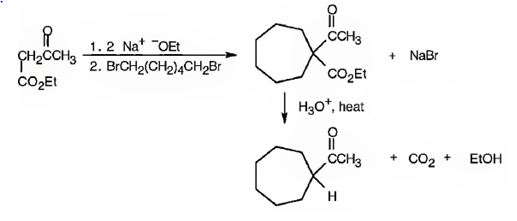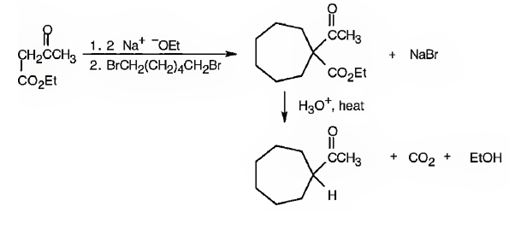
a)

Interpretation:
How to prepare the compound shown using either an acetoacetic ester synthesis or malonic ester synthesis is to be shown.
Concept introduction:
Acetoacetic ester synthesis converts an
Both reactions involve the same steps such as i) enolate ion formation ii) SN2 attack of the enolate anion on the alkyl halide iii) hydrolysis and decarboxylation.
To show
How to prepare the compound shown using either an acetoacetic ester synthesis or malonic ester synthesis.
Answer to Problem 46AP
The compound shown can be prepared by using malonic ester synthesis.

Explanation of Solution
The compound shown is a derivative of carboxylic acid. Hence it can be prepared using malonic ester synthesis. The acid has two methyl groups attached to the carbon adjacent to ester groups. It can be prepared by replacing the two hydrogens on the active methylene group of malonic ester by two methyl groups. This is achieved by treating the ester with two equivalents of sodium ethoxide and two equivalents of methyl bromide.
The compound shown can be prepared by using malonic ester synthesis.

b)

Interpretation:
How to prepare the compound shown using either an acetoacetic ester synthesis or malonic ester synthesis is to be shown.
Concept introduction:
Acetoacetic ester synthesis converts an alkyl halide in to a methyl ketone having three more carbons. The methyl ketone part comes from acetoacetic eater while the remaining carbon comes from the primary alkyl halide. Malonic ester synthesis converts an alkyl halide to a carboxylic acid having two more carbon atoms.
Both reactions involve the same steps such as i) enolate ion formation ii) SN2 attack of the enolate anion on the alkyl halide iii) hydrolysis and decarboxylation.
To show
How to prepare the compound shown using either an acetoacetic ester synthesis or malonic ester synthesis.
Answer to Problem 46AP
The compound shown can be prepared by using an acetoacetic ester synthesis as shown below.

Explanation of Solution
: The compound is a methyl ketone. Hence it can be prepared using aceto acetic ester synthesis. The base ethoxide ion abstracts a proton from the active methylene group of acetoacetic ester to yield the enolate anion. The nucleophilic attack of the anion on 1,6- dibromohexane displaces the bromide ion to produce a α- substituted acetoacetic ester. The second acidic hydrogen of the ester is then removed by another ethoxide ion which is followed by the nucleophilic attack of the anion on the other carbon bearing bromine to produce a cyclic ester. Upon treating with aqueous acids the ester group gets hydrolyzed to give a β- ketocarboxylic acid. The ketocarboxylic acid eliminates a CO2 molecule on heating to yield methyl cycloheptyl ketone.
The compound shown can be prepared by using an acetoacetic ester synthesis as shown below.

c)

Interpretation:
How to prepare the compound shown using either an acetoacetic ester synthesis or malonic ester synthesis is to be shown.
Concept introduction:
Acetoacetic ester synthesis converts an alkyl halide in to a methyl ketone having three more carbons. The methyl ketone part comes from acetoacetic eater while the remaining carbon comes from the primary alkyl halide. Malonic ester synthesis converts an alkyl halide to a carboxylic acid having two more carbon atoms.
Both reactions involve the same steps such as i) enolate ion formation ii) SN2 attack of the enolate anion on the alkyl halide iii) hydrolysis and decarboxylation.
To show
How to prepare the compound shown using either an acetoacetic ester synthesis or malonic ester synthesis.
Answer to Problem 46AP
The compound shown can be prepared by using malonic ester synthesis.

Explanation of Solution
The compound shown is a carboxylic acid. Hence it can be prepared using malonic ester synthesis. The base ethoxide ion abstracts a proton from the active methylene group of malonic ester to yield the enolate anion. The nucleophilic attack of the anion on 1,3- dibromopropane displaces the bromide ion to produce a α- substituted malonic ester. The second acidic hydrogen of the ester is then removed by another ethoxide ion which is followed by the nucleophilic attack of the anion on the other carbon bearing bromine to produce a cyclic diester. Upon treating with aqueous acids the ester groups get hydrolyzed to give a dicarboxylic acid. The dicarboxylic acid eliminates a CO2 molecule on heating to yield cyclobutylcarboxylic acid.
The compound shown can be prepared by using malonic ester synthesis.

d)

Interpretation:
How to prepare the compound shown using either an acetoacetic ester synthesis or malonic ester synthesis is to be shown.
Concept introduction:
Acetoacetic ester synthesis converts an alkyl halide in to a methyl ketone having three more carbons. The methyl ketone part comes from acetoacetic eater while the remaining carbon comes from the primary alkyl halide. Malonic ester synthesis converts an alkyl halide to a carboxylic acid having two more carbon atoms.
Both reactions involve the same steps such as i) enolate ion formation ii) SN2 attack of the enolate anion on the alkyl halide iii) hydrolysis and decarboxylation.
To show
How to prepare the compound shown using either an acetoacetic ester synthesis or malonic ester synthesis.
Answer to Problem 46AP
The compound shown can be prepared by using an acetoacetic ester synthesis as shown below.

Explanation of Solution
The compound is a methyl ketone. Hence it can be prepared using aceto acetic ester synthesis. The base ethoxide ion abstracts a proton from the active methylene group of acetoacetic ester to yield the enolate anion. The nucleophilic attack of the anion on allyl bromide displaces the bromide ion to produce α- allylsubstituted acetoacetic ester. Upon treating with aqueous acids the ester group gets hydrolyzed to give a β- ketocarboxylic acid. The ketocarboxylic acid eliminates a CO2 molecule on heating to yield hex-5-ene-2-one.
The compound shown can be prepared by using an acetoacetic ester synthesis as shown below.

Want to see more full solutions like this?
Chapter 22 Solutions
EBK ORGANIC CHEMISTRY
- Q5: Label each chiral carbon in the following molecules as R or S. Make sure the stereocenter to which each of your R/S assignments belong is perfectly clear to the grader. (8pts) R OCH 3 CI H S 2pts for each R/S HO R H !!! I OH CI HN CI R Harrow_forwardCalculate the proton and carbon chemical shifts for this structurearrow_forwardA. B. b. Now consider the two bicyclic molecules A. and B. Note that A. is a dianion and B. is a neutral molecule. One of these molecules is a highly reactive compound first characterized in frozen noble gas matrices, that self-reacts rapidly at temperatures above liquid nitrogen temperature. The other compound was isolated at room temperature in the early 1960s, and is a stable ligand used in organometallic chemistry. Which molecule is the more stable molecule, and why?arrow_forward
- A mixture of C7H12O2, C9H9OCl, biphenyl and acetone was put together in a gas chromatography tube. Please decide from the GC resutls which correspond to the peak for C7,C9 and biphenyl and explain the reasoning based on GC results. Eliminate unnecessary peaks from Gas Chromatography results.arrow_forwardIs the molecule chiral, meso, or achiral? CI .CH3 H₂C CIarrow_forwardPLEASE HELP ! URGENT!arrow_forward
- Identify priority of the substituents: CH3arrow_forwardHow many chiral carbons are in the molecule? OH F CI Brarrow_forwardA mixture of three compounds Phen-A, Acet-B and Rin-C was analyzed using TLC with 1:9 ethanol: hexane as the mobile phase. The TLC plate showed three spots of R, 0.1 and 0.2 and 0.3. Which of the three compounds (Phen-A; Acet-B or Rin-C) would have the highest (Blank 1), middle (Blank 2) and lowest (Blank 3) spot respectively? 0 CH: 0 CH, 0 H.C OH H.CN OH Acet-B Rin-C phen-A A A <arrow_forward

 Organic ChemistryChemistryISBN:9781305580350Author:William H. Brown, Brent L. Iverson, Eric Anslyn, Christopher S. FootePublisher:Cengage Learning
Organic ChemistryChemistryISBN:9781305580350Author:William H. Brown, Brent L. Iverson, Eric Anslyn, Christopher S. FootePublisher:Cengage Learning EBK A SMALL SCALE APPROACH TO ORGANIC LChemistryISBN:9781305446021Author:LampmanPublisher:CENGAGE LEARNING - CONSIGNMENT
EBK A SMALL SCALE APPROACH TO ORGANIC LChemistryISBN:9781305446021Author:LampmanPublisher:CENGAGE LEARNING - CONSIGNMENT


